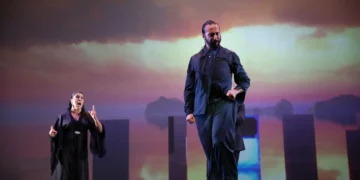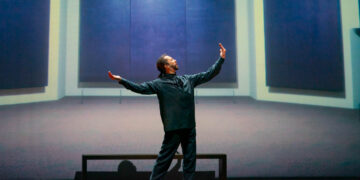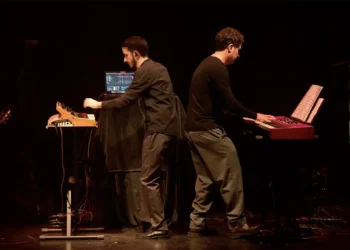|
XV FESTIVAL DE JEREZ
|
|
Text: Estela Zatania The next to last day of the Festival de Jerez was full of activities and performances. After the educational workshop “Distinguir los Palos” at the Centro Andaluz de Flamenco, Eva Yerbabuena presented her show “Cuando yo era…”, which is going to be the final work of the extensive program. At midday, the critics covering the festival for a variety of media voted dancer Leonor Leal “Artista Revelación” for this year, in recognition of her work “¡eLe, eLe!” on March 1st and 2nd. At seven in the evening at the Sala Paúl, one of the alternative venues, the instrumental group “UHF, Ultra High Flamenco” presented their second recording “Bipolar”. Devoted to flamenco jazz, the charismatic group is made up of musicians José Quevedo on guitar, Pablo Martín on double bass, Alexis Lefèvre on violin and Paquito González on percussion. Aside from a 12-count (or 8-count) compás, and the occasional excursion through flamenco cadences, these experienced professionals play a musical genre which is so well-defined and of high quality, it could receive a label of its own, independently of flamenco. They played pieces from their record such as “OFNI, unidentified flamenco object”, and a composition to the compás of siguiriyas with a contemporary dynamic, thus delighting the mostly youthful audience. NUEVO BALLET ESPAÑOL “CAMBIO DE TERCIO” Dance: Rojas y Rodríguez. Corps de ballet: María López, Pilar González, Verónica Lópiz, Raquel Tamarit. Cante: Davinia Jaén, Sandra Rincón. Guitar: Daniel Jurado, Gaspar Rodríguez. Violin: Raúl Márquez. Percussion: Enrique Terrón. Original idea: Rojas y Rodríguez. At the beginning of the show at the Villamarta Theater, it was announced that as an expression of solidarity, the performance of Rojas and Rodríguez’ “Nuevo Ballet Español” was dedicated to the people of Japan. Continuing in the contemporary vein begun at the Paúl two hours earlier, the company presented their creation “Cambio de Tercio”, literally, “a change of pace”, a work aimed at discovering new paths via old, well-worn ones. At the previous day’s press conference the men who head the group talked about the “alleged purity” of flamenco, a genre based on constant mixture. Oddly enough, the most noteworthy thing about this show is the tribute it pays to precisely the most traditional sort of flamenco. In fact, “Cambio de Tercio” displays the infinite possibilities that exist for the taking without ever rejecting the forms and cantes of all time, the more classic the better. It becomes clear that flamenco doesn’t appear or disappear from holding your hand a certain way, playing an unusual chord, or the great bugaboo, wearing polkadots. Flamenco has its own peculiar aroma, and the crystalline intelligence and knowledge of Rojas and Rodríguez allows them to keep it intact, even as they push the aesthetic limits to see how far they can go. “Essentialize” is the word that comes to mind.
Every detail is carefully managed, beginning with the beautiful lighting of David Pérez, and a well-chosen wardrobe for the purpose. The musicians are a part of the action, and even the bows are thought out. Two female singers full of energy, while not superstars, do an absolutely admirable job with such unusual assignments as simultaneously singing different verses of alegrías, without guitar, each one a different style, or the classic spoken tanguillo verses of the kind popularized by Lola Flores in her day with “Las Guapas de Cádiz”. The kind of flamenco that could be called “historic” is represented without ridiculing it. There’s a varied menu of traditional forms, from the most common such as fandangos, cantiñas or siguiriyas, to unexpected things like bamberas or sevillanas among others, always with impeccable flamenco sensibility. Everything is there on display forcing the spectator to rethink prejudices or possibly ill-informed concepts, and rectify one’s own definition of what flamenco is and is not. A certain coldness on the part of the audience seemed to indicate they weren’t getting it, something which may have been due to the novelty of the show, which is, in itself admirable. In this work there’s a message that comes through loud and clear, but you have to be amenable to receiving it.
JOSÉ MAYA “MAYA” The organization of the Festival de Jerez aims to include all styles to suit a variety of tastes. Over the years, shows considered “experimental” have been relegated to secondary venues such as the Sala Compañía, while the most traditional offerings had their place at the Villamarta. But the swift evolution of the genre has changed perspectives, and last night young dancer José Maya, an excellent exponent of the most classic Farruco school, presented his show of traditional but young flamenco at the Compañía. With the guitars of Pino Losada and Antonio Jiménez, and the singing of Mara Rey, Rubio de Pruna and Simón Rubio, he offered a conventional small format program with a capella bulerías and siguiriyas, perhaps a bit too much footwork, but doing a fine job of conserving and honoring this energetic racial way of feeling flamenco.
The after-hours program got underway at one in the morning at the Peña la Bulería with dance teacher Ana María López’ group. |





 In order to achieve this, they depend on an abundance of good singing and guitar work, as well as the choreography of Rafael Campallo, Manolo Liñán and Rocío Molina, in addition to their own. They make use of a complete arsenal of classic accessories – bata de cola, shawl, castanets, the flower in the girls’ hair (the younger generation saw fit to eliminate this inoffensive detail), or wide-brimmed hat for the men and short dresses for the women, as was the fashion in flamenco dance in the fifties and early sixties.
In order to achieve this, they depend on an abundance of good singing and guitar work, as well as the choreography of Rafael Campallo, Manolo Liñán and Rocío Molina, in addition to their own. They make use of a complete arsenal of classic accessories – bata de cola, shawl, castanets, the flower in the girls’ hair (the younger generation saw fit to eliminate this inoffensive detail), or wide-brimmed hat for the men and short dresses for the women, as was the fashion in flamenco dance in the fifties and early sixties.




















